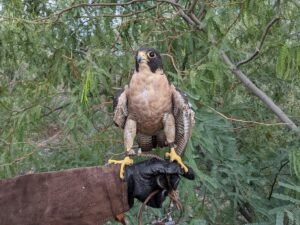Peregrine Falcon – Zephyr
 Name: Zephyr – Male
Name: Zephyr – Male
Species: Peregrine Falcon
Liberty Arrival: Fall 2017/Adult
Injury/Condition: Left wing injury
Zephyr was transferred to Liberty Wildlife from another rehabilitator as a 2-year adult. A veterinary examination revealed that he had a healed fracture to his left metacarpus, the bone at the tip of the wing. Although Zephyr had some flying ability, he had trouble maintaining elevation. After observations of Zephyr’s difficulties in the flight cage, he was judged to be non-releasable. Liberty is fortunate to have another handsome male peregrine as part of our education group.
Peregrine Falcon Facts
Description: The peregrine falcon has one of the most global distributions of any bird of prey. This falcon is found on every continent except Antarctica.
Life span: Though most peregrine falcons do not live to be 1 year old (survival rate for the first year is 40%), the average age of those that live beyond the first year is 13. In the wild, the Peregrine Falcon lives from 7 to 15 years. Maximum longevity records for banded birds range from 16 to 20 years.
Prey: The peregrine falcon captures its prey in the air since its primary food consists of birds such as starlings, mourning doves, pigeons, pheasants, and waterfowl.
Babies/Nests: Falcons do not build nests, but rather dig small depressions called “scrapes” in sand, dirt, or debris or in high cliffs, trees, or tall buildings. Sometimes they will use an abandoned hawk’s or raven’s nest. The female will lay between 2 and 6 eggs and the eggs will hatch in 33 to 35 days. The young fledge in 35 to 42 days.
Halcón Peregrino – Zephyr
Nombre: Zephyr – Macho
Especie: Halcón Peregrino
Llegada a Liberty: Otoño 2017/Adulto
Herida/Condición: Herida a su ala izquierda
Zephyr fue transferido a Liberty Wildlife de otro centro der rehabilitación como un adulto de 2 años. Una examinación del veterinario concluyo que tenia una herida curada en su metacarpo izquierdo, el hueso en la punta de su ala. Aunque Zephyr tenia alguna habilidad de poder volar, tenia dificultades manteniendo elevación. Después de observar las dificultades que tenia Zephyr en el encerramiento de vuelo, fue juzgado que no podía ser liberado. Liberty es afortunado de tener otro peregrino macho como parte de nuestro equipo educativo.
Datos del Halcón Peregrino
Descripción: El halcón peregrino tiene una de las distribuciones mas amplias de cualquier ave de rapiña. Este halcón se encuentra en todos los continentes excepto Antártica.
Duración de vida: Aunque la mayoría de los halcones peregrinos no alcanzan a vivir un año (su tasa de supervivencia de un año es 40%); el promedio de esos que si sobreviven su primer año es 13 años. En el estado salvaje, el halcón peregrino vive de 7 a 15 años. Datos han enseñado que pueden vivir 16 a 20 años.
Presa: El halcón peregrino captura su presa en el aire como comida principalmente consiste en pájaros como estorninos, huilotas, palomas, faisánes, y aves acuáticas.
Nidos: Los halcones peregrinos no construyen nidos, si no excavan hoyos pequeños en la arena o tierra, o en acantilados altos arboles, o edificios altos. Algunas veces usan nidos abandonados de halcones o cuervos.
Crías: La hembra pone 2 a 6 huevos y salen de su cascaron en 33 a 35 días. Los jóvenes se van en 35 a 42 días.


